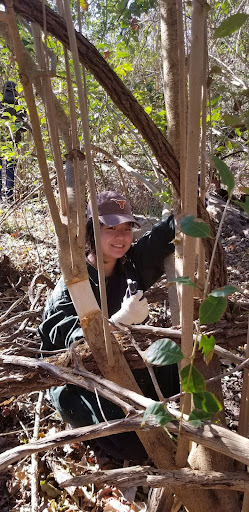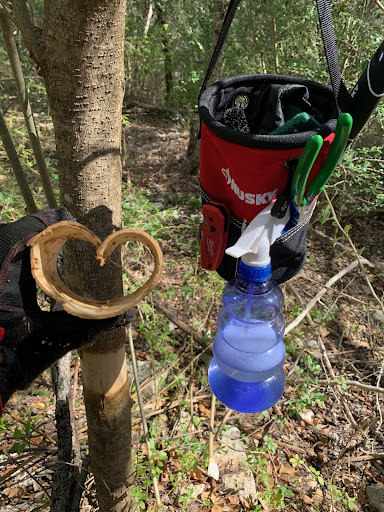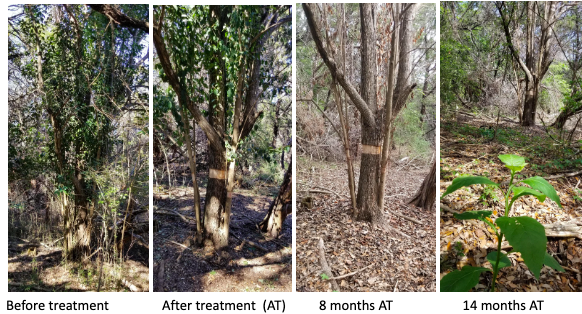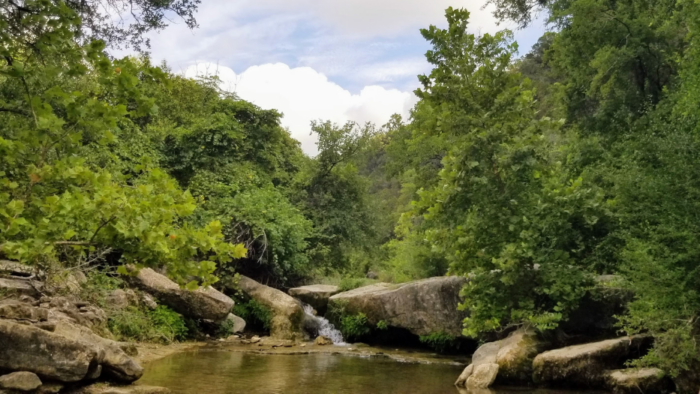The Bull Creek watershed, located in Austin, has been called “the Galapagos of Texas” by locals due to its ecological diversity and geological features. With an 11-mile spring-fed creek dotted with waterfalls and swimming holes, limestone seeps, and scenic cliffs, the watershed is home to more than 600 native plant species. The endangered Golden-cheeked Warbler and the Jollyville Plateau Salamander are just a few examples of Bull Creek’s diverse and unique fauna. Native species still find suitable habitats in the watershed despite the ever-increasing pressure of urban development.
The Stenis tract is a 57-acre parcel of Water Quality Protection Land located in Upper Bull Creek and the focus of A Rocha USA restoration efforts in Central Texas. In collaboration with the Bull Creek Foundation, we are managing invasive plant species that threaten the health of the riparian forest, the wooded area adjacent to the creek.
Invasive plants are characterized as non-native (exotic) species within a given ecosystem. Their introduction poses a threat to the ecosystem and/or human health. When they find favorable conditions, invasive plants can reproduce fast. They displace native plants and can take over large areas. If left unchecked, they change the dynamic of entire ecosystems, decreasing biodiversity and threatening the survival of native plants and animals. In Texas, most invasive plant species have been inadvertently introduced and spread by humans as ornamental plants or forage for cattle. The invasive plants we identified in the Stenis tract forest are ornamental plants that found their way to the Bull Creek watershed.

Volunteers working at the Stenis tract. Photos by Verónica Godoy.
Managing invasive plant species at the Stenis tract is a community effort. It requires combining scientific knowledge, local expertise, and many determined volunteers. When we started the restoration project in 2021, we knew invasive plants existed at the tract, but we did not know the extent of the infestation. So we set out to answer two questions: What are the most abundant invasive species? Where are they located? To find the answers, we decided to survey the 34-accessible acres of the tract and create a comprehensive map of the invasive plants. We used the free software EDDMapS and the smartphone application EDDMapS Pro developed by The Center of Invasive Species and Ecosystem Health at the University of Georgia. The smartphone application allowed us to geolocalize individual plants or areas infested by invasives. For each data point collected in the field, we documented the species name, habitat type, severity of the infestation, and took photos to back up the plant identification. After a verification process by local experts, the data we collected became part of the EDDMapS database and it is now public.
With the support of the Bull Creek Foundation folks and the help of Capital Area Master Naturalists, we mapped 24 acres, 70% of the designated area. We found that glossy privet (Ligustrum lucidum), a tree from South Asia, is the most abundant invasive plant, accounting for 58% of the observations. Heavenly bamboo (Nandina domestica), a shrub from Asia, came second, representing 32% of the data points. In the 24 acres surveyed, we recorded 785 privet and heavenly bamboo. The results are not surprising. Introduced in Central Texas for their ornamental appeal decades ago, both species have spread from people’s yards to Austin’s natural areas and parks, displacing native plants and causing habitat degradation. We also found other usual suspects: the invasive vine Japanese honeysuckle (Lonicera japonica) and deciduous trees Chinese tallow (Triadica sebifera), chinaberry (Melia azedarach), and Chinese pistache.
This map shows where glossy privet and heavenly bamboo represent 25% or more of the plant community. In these “hot spots,” 10 to 50+ invasive plants grow together. These invasive plants tend to grow in higher numbers closer to the creek, where moisture in the ground is available.
Next, we developed a plan to manage glossy privet. This highly invasive tree reproduces fast and efficiently. Mature glossy privets can produce 100,000+ seeds per season. The seeds have an astonishing germination rate of 75 to 95%! They grow and reach maturity fast, within 10 years or less, and their canopies cast a dense shade preventing understory plants or other trees from growing. The problem intensifies when glossy privets dominate an area, creating “islands” of low plant biodiversity. We are happy to report that with an investment of 10 workdays and the help of 62 volunteers, we cleared privets from five infested areas!
To do so, we first removed saplings and young privets manually or using a weed wrench. Then, we girdled mature trees following a technique perfected by Cliff Tillick, a local volunteer and plant invasives expert. Girdling kills the tree slowly by cutting the flow of nutrients from the leaves to the roots. The roots eventually die of starvation, causing the whole tree to die. Using a knife and a scraper, we cut and remove a 5 to 8 inch strip of bark around the trunk, down to the sapwood. Lastly, we spray the girdled area with a mix of soap and water and scrape the surface again to remove the remaining pieces of bark. If the tree has more than one trunk, as most privet do, we repeat the operation for each trunk. We return to the treated area every two months to inspect the trees, cut the new branches growing under the girdled ring, and manually remove emerging saplings. The process can take between 8 months to more than a year. Even though girdling is time-consuming, it has a high success rate of 90% or more if executed correctly. In the five areas we treated, we girdled 156 mature trees, extracted 158 young trees, and pulled out more than 780 saplings!

Left: Girdled glossy privet. The removed bark is shown in the shape of a heart. Right: volunteers working on a girdled privet. -Photos: Rachel McGill and Verónica Godoy.
We are seeing the first fruits of our fight against privets. The photos below show a timeline of the first glossy privet we girdled in January 2022 with a group of volunteers. This glossy privet is the biggest we have found at the Stenis tract, with a diameter of 40 cm and a height of 20+ feet. It was surrounded by a “mini forest” of over a hundred young privets. Eight months after treatment, the area showed no signs of new invasives emerging, and we declared the tree officially dead. The sun can now reach beneath the forest canopy. Native plants are returning – Virginia creeper, inland sea oats, and frostweed, among others – and slowly restoring the plant community to health.

While we continue clearing privets in the Stenis tract, we plan to finish mapping the remaining 30% of the land and start managing Nandina domestica. If you live in the Austin area, would you consider joining us? You can also support our work by giving to A Rocha USA and praying for our staff, partners, and volunteers. Ecological restoration is a community effort and we would love to see you participate.









Add a Comment